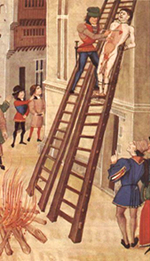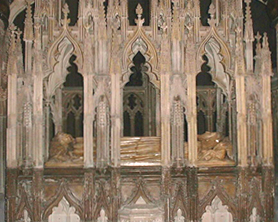King Edward II - Part 2
After this disaster, Edward’s skills as a military tactician lost all credibility and over the next six years, England began to divide into pro-and anti-royalist factions. King Edward's main royalist supporters were Hugh le Despenser and his son, (also Hugh le Despener) who were both friends of the late Piers Gaveston. Edward made the younger Despenser the Court Chamberlain and married him to a daughter of Joan of Acre who had once been Countess of Gloucester and this brought as a dowry, the county of Glamorgan. This caused much territorial discontent in Wales involving the Earl of Lancaster and Roger Mortimer Earl of March. The ambitious Lancaster was effectively controlling the kingdom having such a large private army and along with Mortimer, he made a bid to get rid of the Despensers. By 1321, the Mortimer-Lancaster alliance had managed to force the king to banish the Despensers but this was something that Edward felt he could not tolerate and so he led a campaign against the two antagonists and in the year 1322, he executed Lancaster (the latter being beheaded in the presence of Edward himself) and took Mortimer prisoner. Soon after, the Despensers were reinstated at court and the Lord's Ordainers were dissolved and with them any limitations on royal power. The king would no longer be subject to the will of Parliament, and the Lords, Prelates, and Commons were to suffer his will in silence. Opposition to Edward and the Despensers’ rule continued however and in 1324 there was a foiled assassination attempt on their lives.
Also in 1324, Roger Mortimer managed, with the help of Queen Isabella, to escape from the Tower of London and a year later became her lover after she joined him in France. A dispute between France and England had broken out over Edward's refusal to pay homage to the French king for the territory of Gascony. After several failed attempts to regain the territory, Edward sent his wife, Isabella, to negotiate peace terms. Isabella arrived in France in March 1325. She was now able to visit her family and native land as well as escape the Despensers and the king, all of whom she now detested. The pair took advantage when Edward's son and heir (the future Edward III) arrived in France to pay homage to the French king and they refused to allow him to return to England. Their intention of course by this time was to overthrow Edward and install the young prince on the English  throne. In September 1326, Queen Isabella, Mortimer, the young prince and also his uncle the Earl of Kent (the 23-year-old son of Edward I and Margaret of France) landed in Suffolk. Barons and burghers soon hurried to join them and this newly formed army marched to the west proclaiming the Prince as Governor of England. Unfortunately for Edward, no one wanted to support him and after wandering helplessly for some weeks in Wales, the king was taken prisoner on 16 November. He was soon imprisoned in Kenilworth under the dubious care of his cousin Henry, Earl of Lancaster, the younger brother of the executed Thomas of Lancaster!
throne. In September 1326, Queen Isabella, Mortimer, the young prince and also his uncle the Earl of Kent (the 23-year-old son of Edward I and Margaret of France) landed in Suffolk. Barons and burghers soon hurried to join them and this newly formed army marched to the west proclaiming the Prince as Governor of England. Unfortunately for Edward, no one wanted to support him and after wandering helplessly for some weeks in Wales, the king was taken prisoner on 16 November. He was soon imprisoned in Kenilworth under the dubious care of his cousin Henry, Earl of Lancaster, the younger brother of the executed Thomas of Lancaster!
Both older and younger Despensers respectively were executed in October and November of 1326. Hugh Despenser the younger was particularly brutally executed in front of a huge crowd purely for public entertainment. First they dragged him from his horse, stripped him naked, scrawled Biblical verses against corruption on his skin. They then dragged him into the city, presenting him to Queen Isabella, Roger Mortimer, and the Lancastrians in the market square. He was then condemned to hang as a thief, to be castrated, and then to be drawn and quartered as a traitor, his quarters to be dispersed throughout England.
Right: The execution of Hugh Despenser
 On January 20 1327 Edward II was forced to abdicate in favour of his son after being threatened that his younger children would be killed unless he gave up the throne he was moved to Berkeley Castle in Gloucestershire where Queen Isabella and Mortimer tried to contrive some means to do away with him without leaving any obvious signs of a violent end. Edward was very badly treated both physically and psychologically but his strong constitution refused to submit to this degradation, deprivation and exposure to disease. Ultimately on September 22 1327, on the orders of the Bishop of Hereford, Edward was savagely murdered by the insertion of a red-hot iron bar via his anus into his bowels causing him an excruciatingly agonising death but without leaving any obvious signs of violence on the body.
On January 20 1327 Edward II was forced to abdicate in favour of his son after being threatened that his younger children would be killed unless he gave up the throne he was moved to Berkeley Castle in Gloucestershire where Queen Isabella and Mortimer tried to contrive some means to do away with him without leaving any obvious signs of a violent end. Edward was very badly treated both physically and psychologically but his strong constitution refused to submit to this degradation, deprivation and exposure to disease. Ultimately on September 22 1327, on the orders of the Bishop of Hereford, Edward was savagely murdered by the insertion of a red-hot iron bar via his anus into his bowels causing him an excruciatingly agonising death but without leaving any obvious signs of violence on the body.
Left: Edward II Tomb in Gloucester Cathedral
King Edward II was only 43 years old at the time of his gruesome murder!


